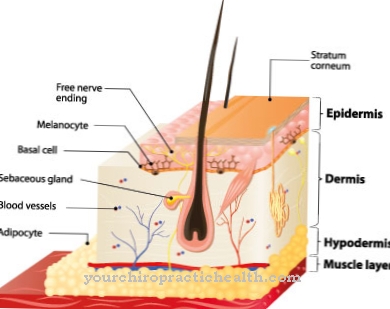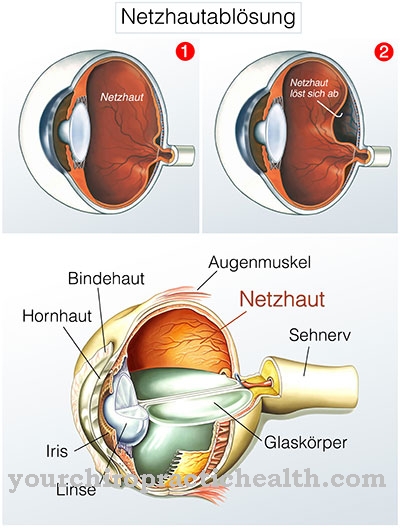A Rhabdomyosarcoma belongs to the group of soft tissue tumors; Rhabdomyosarcomas arise from degenerate or not fully mature cells of the muscle or connective tissue. Rhabdomyosarcoma almost exclusively affects children; 87% of all sick people are younger than 15 years. Boys are affected slightly more often than girls.
What is rhabdomyosarcoma?

© Tyler Olson - stock.adobe.com
A Rhabdomyosarcoma arises from degenerate cells of the muscle tissue. A rhabdomyosarcoma can occur practically anywhere in the body, although an accumulation of foci in the area of the paranasal sinuses, the nasal and pharynx, the eye sockets, the bladder cavity and the vagina has been established.
Rhabdomyosarcoma affects adults very rarely, and rhabdomyosarcoma usually occurs in children under 15 years of age. Boys are more likely to be affected than girls with a probability of 1 in 4.
causes
Causes for a Rhabdomyosarcoma could not be clearly established so far. However, there is a connection between the occurrence of certain pre-existing conditions and the occurrence of rhabdomyosarcoma.
Previous radiation therapy or an infection with the HI or EB virus have a negative effect on the probability of developing rhabdomyosarcoma.
A genetic connection is also suspected, in particular a disease of the genetically caused Li-Fraumeni syndrome. It is very likely that the tumor cells stem from mesenchymal cells - embryonic cells from which muscle and connective tissue later develop.
Symptoms, ailments & signs
Symptoms of rhabdomyosarcoma depend on the extent and location. Usually the head, the urogenital tract and the extremities are affected. Adults rarely suffer from the disease, and children more so. Most of the time, the tumors spread the disease to other nearby areas of the body. Metastases develop. The brain and pelvic organs are noticeably affected. The individual manifestation of the complaints knows hardly any limits.
The protruding eyeballs are typical of rhabdomyosarcoma in the head and neck region. Sometimes there is also swelling on the jaw. Breathing through the nose is difficult. Some patients even report hearing impairment. If the urogenital tract is affected, patients complain of painful urination.
A burning sensation accompanies urination. The excretion is not infrequently mixed with blood. Abdominal pain also occurs very often, which indicates the spread of the infestation. Depending on the gender, there are other signs. Male patients have swollen testicles, female patients have vaginal bleeding.
If the rhabdomyosarcoma occurs on the extremities, swelling occurs there. They don't have to be painful. In addition, the affected body appendages can no longer be moved as usual.
Diagnosis & course
A Rhabdomyosarcoma forms clearly palpable swellings and swellings. Tumors that are too small for palpation or only visible under a microscope can occur less frequently.
The patient will also feel pain and, depending on the location and size of the tumor, will have to accept significant restrictions in movement. If a doctor can feel tumors or detect them after a sonography (examination with ultrasound), he will take further diagnostic steps. This essentially includes the biopsy. With a thin needle he will remove tissue under local anesthesia and then have a pathological examination. The procedure is an outpatient procedure and does not cause pain. The laboratory doctor can infer a rhabdomyosarcoma based on the cell properties.
After a positive result, the doctor will clarify the degree of the disease. To do this, he will use computed tomography or magnetic resonance imaging (MRI) to determine whether the tumor has already metastasized or whether only the primary tumor is present. He will also determine whether it is a relapse (cancer that has occurred again from a previous, same cancer). Depending on the degree of the disease, the doctor will initiate further therapeutic steps.
Complications
If left untreated, rhabdomyosarcoma leads to death within a few weeks or months because it spreads quickly through the bloodstream and lymphatic system. Today, however, the prognosis has improved significantly due to the intensive treatment with significantly more effective chemotherapeutic agents.In addition, the prognosis and the development of complications depend on the type of rhabdomyosarcoma.
The alveolar rhabdomyosarcoma grows much more aggressively than the so-called embryonic rhabdomyosarcoma. The formation of metastases also takes place much faster in alveolar rhabdomyosarcoma. The same applies to the risk of relapses. Although rhabdomyosarcomas can occur in almost all organs, they prefer the head and neck area, the limbs as well as the urinary and genital organs.
The symptoms that arise depend on the location of the respective rhabdomyosarcoma. Abdominal pain, painful urination, and blood in the urine are common. Metastases are initially found in the neighboring lymph nodes, in the skeletal system and in the lungs. A complete cure of rhabdomyosarcoma is possible today if intensive cancer therapy begins before metastases appear.
However, successful surgical removal of the tumor also depends on its location. After the complete removal, radiation therapy is used. Tumors that have not been fully recorded can recur again years later. In addition, the risk of metastases forming is increased in this case.
When should you go to the doctor?
Since rhabdomyosarcoma is a tumor, it should always be treated by a doctor. This disease does not self-heal, and the rhabdomyosarcoma cannot be treated by self-help measures. In the worst case, the person concerned will die if left untreated. An early diagnosis of the disease always has a very positive effect on the further course. As a rule, the doctor should be consulted in the case of rhabdomyosarcoma if the person affected suffers from severe swelling of the eyes or protruding eyeballs.
The affected person's breathing is also difficult, so that strenuous activities or sporting activities cannot be carried out without further ado. In girls, rhabdomyosarcoma often causes vaginal bleeding for no particular reason. Painful urination can also indicate this condition and should be evaluated and treated by a doctor.
The diagnosis of rhabdomyosarcoma is usually made in a hospital. Further treatment is then carried out by a specialist depending on the symptoms. Rhabdomyosarcoma may also limit the life expectancy of those affected.
Treatment & Therapy
As a rule, the tumor is first removed by surgery. A computed tomography or magnetic resonance tomography produced as part of the diagnosis facilitates the planning of the operation and limits the area in which the irradiation takes place.
In addition to radiation therapy, chemotherapy is attempted. Both are intended to prevent any tumor cells that may still be present from spreading or growing further. If the tumor is not operable, an attempt is first made to shrink the tumor with chemotherapy so that it can then be removed by surgery.
If the combined therapy of tumor removal, radiation and chemotherapy is successful, the prognosis is good. The 5-year forecast is 70%. If metastases have already formed, the prognosis is around 30%. If it is a relapse, the prognosis is significantly lower.
prevention
One Rhabdomyosarcoma cannot be prevented. However, it is recommended that children with an unfavorable pre-existing illness (EBV or HIV infection, previous radiation therapy, present Li-Fraumeni syndrome) see a doctor at close intervals. If a child repeatedly complains of pain in the throat, nose, eye sockets, or vagina, they should also see a doctor.
After the disease of rhabdomyosarcoma has been overcome or treated, the person affected should also be examined closely for a new disease. Especially in the case of children at risk, a healthy lifestyle - healthy diet, lots of exercise in the fresh air - should reduce the likelihood of developing cancer.
Aftercare
The disease is very serious and must be treated by a doctor. However, there are many therapies that sufferers can perform at home. This can alleviate the symptoms. For sufficient regeneration, those affected should take it easy after the treatment.
Since the immune system is extremely weakened after the treatment, contact with sick people in the social environment should be avoided. Those affected should have an intact sleep hygiene. Getting enough sleep after the treatment is very important. A balanced diet rich in vitamins and exercise should also be tackled after the treatment.
This significantly strengthens the immune system. Since in most of the cases the disease is a great burden for those affected, it is recommended to undergo permanent psychological counseling. Visiting a self-help group can also help those affected to learn how to live with the disease.
In the self-help group, those affected can also exchange ideas with other sick people and learn new ways to cope with the disease. As a result, many do not feel alone. Close relatives should also be sufficiently involved in life. These can also support and help those affected. Nicotine and alcohol-containing products should be avoided, as this can lead to unwanted complications.
You can do that yourself
Rhabdomyosarcoma is a serious disease that should be treated by experienced doctors. However, self-help in everyday life can support therapies or alleviate their consequences. Depending on whether surgery, radiation or chemotherapy are or have been used, the patient is advised to rest for optimal regeneration. Due to the weakened immune system, contact with people suffering from an infection is better avoided. A good night's sleep is just as important as a healthy diet and sufficient amounts of water to drink.
The thought of suffering from a malignant disease is often stressful. Here self-help groups help to process this finding. It is often children and adolescents who are affected by rhamboymyosarcoma. You benefit from psychologists or psycho-oncologists who specialize in adolescents. Parents can then be involved in these therapies in a targeted manner. This also applies to teachers, so that children can continue to study well during the illness and do not lose touch with the class.
Exercise is a factor that can also be integrated into self-help. Here the individual forces of the patient must be taken into account. A walk in the fresh air is just as helpful as a bit of fitness after having passed therapies. Adult patients better avoid nicotine and alcohol, since vascular toxins are of course not beneficial in cancer.


.jpg)



.jpg)




















